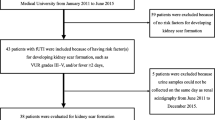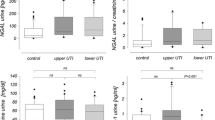Abstract
Introduction
Children with recurrent urinary tract infections (rUTI) often show no identifiable cause of their infections. Neutrophil gelatinase-associated lipocalin (NGAL) is known to be upregulated within the uroepithelium and kidney of patients with UTI and exhibits a localized bacteriostatic effect through iron chelation. We hypothesize that some patients with rUTI without an identifiable cause of their recurrent infections have locally deficient NGAL production. We therefore explored whether a lack of NGAL production may be a factor in the pathogenesis of rUTI.
Materials and methods
Patients seen in the urology clinic for rUTI who were <21 years of age were enrolled. Patients were excluded if they had UTI at the time of enrollment, evidence of renal disease, decreased renal function, known anatomic abnormality of the genitourinary tract, or other reasons that predispose to UTI, such as neurogenic bladder, the need for intermittent catheterization, or unrepaired posterior urethral valves. Control patients were healthy children enrolled from the emergency department with no history of UTI or renal dysfunction, normal urinalysis at the time of enrollment, and presenting no diagnosis associated with increased NGAL levels, such as acute kidney injury or infection. NGAL was measured by immunoblot.
Results
Fifteen cases and controls were enrolled. Median urinary NGAL levels were significantly decreased in rUTI patients compared with controls [15 (14–29) ng/ml vs 30 (27–61) ng/ml; p = 0.002)] Although comparatively diminished, measurable NGAL levels were present in all patients with rUTI.
Conclusions
Urinary NGAL is significantly decreased in patients with compared with patients without rUTI. These data suggest that some patients with rUTI may be predisposed to UTI because of a relative local deficiency in urinary NGAL production.
Similar content being viewed by others
References
Conway PH, Cnaan A, Zaoutis T, Henry BV, Grundmeier RW, Keren R (2007) Recurrent urinary tract infections in children: risk factors and association with prophylactic antimicrobials. JAMA 298:179–186
Mishra J (2003) Identification of neutrophil gelatinase-associated lipocalin as a novel early urinary biomarker for ischemic renal injury. J Am Soc Nephrol 14:2534–2543
Yang J, Goetz D, Li JY, Wang W, Mori K, Setlik D, Du T, Erdjument-Bromage H, Tempst P, Strong R, Barasch J (2002) An iron delivery pathway mediated by a lipocalin. Mol Cell 10:1045–1056
Yilmaz A, Sevketoglu E, Gedikbasi A, Karyagar S, Kiyak A, Mulazimoglu M, Aydogan G, Ozpacaci T, Hatipoglu S (2009) Early prediction of urinary tract infection with urinary neutrophil gelatinase associated lipocalin. Pediatr Nephrol 24:2387–2392
Lundstedt A-C, McCarthy S, Gustafsson MC, Godaly G, Jodal U, Karpman D, Leijonhufvud I, Lindén C, Martinell J, Ragnarsdottir B, Samuelsson M, Truedsson L, Andersson B, Svanborg C (2007) A genetic basis of susceptibility to acute pyelonephritis. PLoS One 2:e825
Fischer H, Lutay N, Ragnarsdóttir B, Ragnarsdóttir B, Yadav M, Jönsson K, Urbano A, Al Hadad A, Rämisch S, Storm P, Dobrindt U, Salvador E, Karpman D, Jodal U, Svanborg C (2010) Pathogen specific, IRF3-dependent signaling and innate resistance to human kidney infection. PLoS Pathog 6:e1001109
Ragnarsdóttir B, Jönsson K, Urbano A, Grönberg-Hernandez J, Lutay N, Tammi M, Gustafsson M, Lundstedt AC, Leijonhufvud I, Karpman D, Wullt B, Truedsson L, Jodal U, Andersson B, Svanborg C (2010) Toll-like receptor 4 promoter polymorphisms: common TLR4 variants may protect against severe urinary tract infection. PLoS One 5:e10734
Paragas N, Kulkarni R, Werth M, Schmidt-Ott KM, Forster C, Deng R, Zhang Q, Singer E, Klose AD, Shen TH, Francis KP, Ray S, Vijayakumar S, Seward S, Bovino ME, Xu K, Takabe Y, Amaral FE, Mohan S, Wax R, Corbin K, Sanna-Cherchi S, Mori K, Johnson L, Nickolas T, D’Agati V, Lin CS, Qiu A, Al-Awqati Q, Ratner AJ, Barasch J (2014) α-Intercalated cells defend the urinary system from bacterial infection. J Clin Invest 124:2963–2976
Paragas N, Qiu A, Zhang Q, Samstein B, Deng SX, Schmidt-Ott KM, Viltard M, Yu W, Forster CS, Gong G, Liu Y, Kulkarni R, Mori K, Kalandadze A, Ratner AJ, Devarajan P, Landry DW, D’Agati V, Lin CS, Barasch J (2011) The Ngal reporter mouse detects the response of the kidney to injury in real time. Nat Med 17:216–222
Mori K, Lee HT, Rapoport D, Drexler IR, Foster K, Yang J, Schmidt-Ott KM, Chen X, Li JY, Weiss S, Mishra J, Cheema FH, Markowitz G, Suganami T, Sawai K, Mukoyama M, Kunis C, D’Agati V, Devarajan P, Barasch J (2005) Endocytic delivery of lipocalin-siderophore-iron complex rescues the kidney from ischemia-reperfusion injury. J Clin Invest 115:610–621
Shaikh N, Hoberman A, Keren R, Gotman N, Docimo SG, Mathews R, Bhatnagar S, Ivanova A, Mattoo TK, Moxey-Mims M, Carpenter MA, Pohl HG, Greenfield S (2016) Recurrent urinary tract infections in children with bladder and bowel dysfunction. Pediatrics 137:1–7
Shaikh N, Hoberman A, Wise B, Kurs-Lasky M, Kearney D, Naylor S, Haralam MA, Colborn DK, Docimo SG (2003) Dysfunctional elimination syndrome: is it related to urinary tract infection or vesicoureteral reflux diagnosed early in life? Pediatrics 112:1134–1137
Kasirga E, Akil I, Yilmaz O, Polat M, Gözmen S, Egemen AL (2006) Evaluation of voiding dysfunctions in children with chronic functional constipation. Turk J Paediatr 48:340–343
Bennett MR, Nehus E, Haffner C, Ma Q, Devarajan P (2014) Pediatric reference ranges for acute kidney injury biomarkers. Pediatr Nephrol 30:677–685
Parmaksız G, Noyan A, Dursun H, İnce E, Anarat R, Cengiz N (2016) Role of new biomarkers for predicting renal scarring in vesicoureteral reflux: NGAL, KIM-1, and L-FABP. Pediatr Nephrol 31:97–103
Acknowledgements
This work was supported by the Frederick Lovejoy Resident Research Fund (Forster), The Society of Pediatric Urology Research Award (Lee), R01 DK096238 (Lee), and R01 DK073462 (Barasch).
Author information
Authors and Affiliations
Corresponding author
Ethics declarations
Conflict of interest
Dr. Jonathan Barasch has a financial relationship with Abbot and Alere, whereby Columbia University has a standard licensing agreement with Abbot and Alere enacted over 10 years ago. Dr. Barasch does not have any direct or indirect commercial incentive associated with publishing this work. The remaining authors have nothing to declare.
Additional information
Richard Bachur and Richard S. Lee contributed equally to this work.
Rights and permissions
About this article
Cite this article
Forster, C.S., Johnson, K., Patel, V. et al. Urinary NGAL deficiency in recurrent urinary tract infections. Pediatr Nephrol 32, 1077–1080 (2017). https://doi.org/10.1007/s00467-017-3607-6
Received:
Revised:
Accepted:
Published:
Issue Date:
DOI: https://doi.org/10.1007/s00467-017-3607-6




